Shahrisabz
Shahrisabz
Shahrisabz is one of the many ancient cities along the old trade routes and large rivers of Central Asia. Since the ancient times, Shakhrisabz has been known for its crafts, the most famous being carpet weaving and fine silk embroidery. As the handicrafts here have a thousand-year history and have absorbed the cultures of the neighboring peoples connected by the Great Silk Road over the centuries.
Shakhrisabz also has an important transport role nowadays as the Great Uzbek Highway passes through it, which actually repeats the route of the Italian traveler and merchant Marco Polo. Shakhrisabz is located 80 km south from Samarkand, at the feet of the Gissar and Zeravshan mountain ranges and at the confluence of the Aksu and Tankhoz rivers in the Southern part of Uzbekistan, belonging to the Qashkadarya region.
There are many sights in Shahrisabz, mainly associated with the time of Amir Temur, including the ruins of his great palace, the Ak Saray. However, due to the redevelopment of the city, many medieval buildings were recently replaced with modern constructions. Therefore, in In 2016, the city was declared as a World Heritage Site in Danger, even though the authorities have promised to take measures to preserve the historical appearance of the city. All the most important sights are easily visited as they are all located inside the central park.


Shahrisabz History
Shakhrisabz was called “Kesh” during the Middle Ages and was also known as the ancient “Nautaca”. In some years along its long history, it emerged as the center of some of the most significant events in world history – sometimes glorious, sometimes tragic. During the Bactrian era, the tsar-impostor, Bess (Artarkserks), was taken in one of the settlements of Nautaca and finally executed by Ptolemy, one of the commanders of Alexander the Great. This meant the end of the great Achaemenid Empire (Persian Empire).
Kesh was chosen by Alexander the Great as a place to spend his winters from 328-327 B.C., from where he set off on a campaign to Oxiarte, where the family of a Bactrian aristocrat was captured. This prize included the beautiful Roxanne, who later became Alexander’s wife. Alexander 4th, the son resulting from this marriage, became the last tsar of the Macedonian dynasty.
It was here, during long evenings, that Alexander got the idea to marry his commanders to local Sogdian and Bactrian women and thus execute his idea to join the East and West. Throughout the millennium, Shakhrisabz was influenced by various dynasties.
Perhaps Shakhrisabz would not yet be as famous as it is if on the 9 April 1346, in the village of Hodja-llgar, Taraguy, the great Amir Timur, the future statesman and great commander, was not born to the family of a noble landlord. Wherever destiny took him throughout his life, Shakhrisabz was always his beloved home city and the place where he spent his childhood and youth. Eventually Shakhrisabz became the second capital of the great country he ruled.
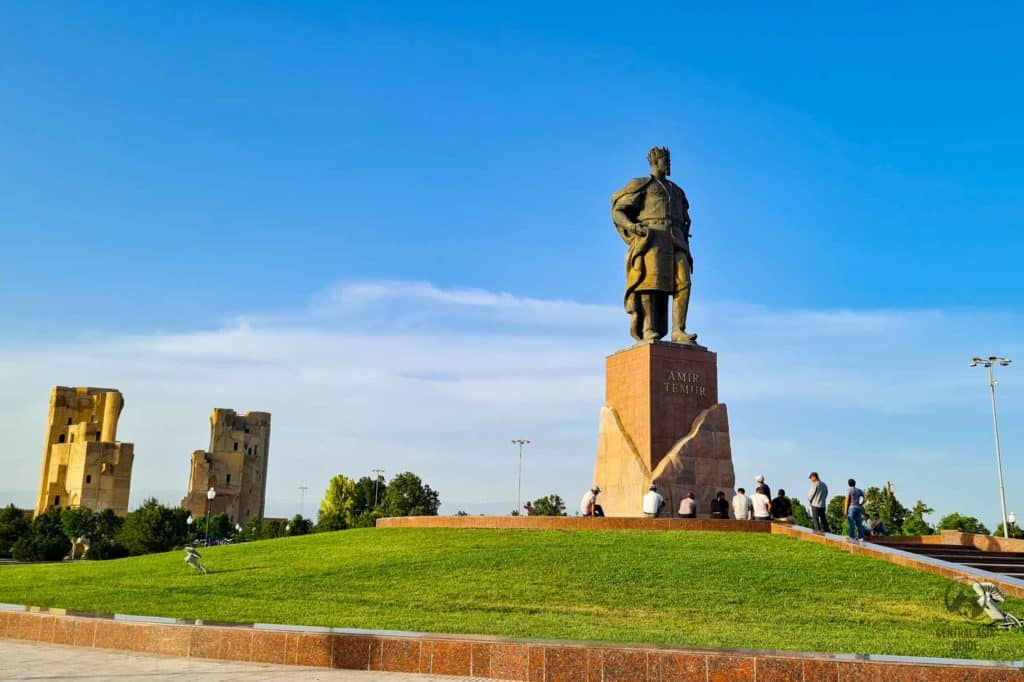
While the Spanish ambassador Ruy Gonzalez de Clavijo stopped in ancient Kesh, heading to Samarkand to the court of Timur, he wrote about the old Shakhrisabz: “The city was surrounded by an earthen wall and a deep channel, and there were drawbridges at the entrances.” Furthermore, Bobur the descendant of Amir Timur, wrote: “…As Kesh was the birthplace of Timurbek, he put much effort into turning the city into “the throne’s pedestal” (government residence)”.
The most visible evidence of this is the vast palace, Ak-Saray, which was incomparable with its contemporaries. During the Timurid era, the city became one of the cultural centers of the East. Great scientists and poets Navoi and Jami have been here. Tamerlane considered making Shakhrisabz the capital of his empire but finally chose Samarkand instead.
what to see in Shahrisabz
Historic Centre of Shakhrisabz
The historic center of Shakhrisyabz includes a number of outstanding monuments and ancient quarters that showcases how the city is developed especially during the period of its apogee, which occured under the rule of Amir Temur and the Timurids in the 15th-16th century. All the highlights of the Shahrisabz sights lie along a 2 km stretch of the town’s main road called Ipak Yoli (Uzbek for ‘Silk Road’). Amir Timur Park and the Ak Sarai (or Ak Serai) are at the northern end of the road, the bazaar is in the middle, and the Dor at-Tilyavat and Dor as-Siadat are slightly further south and can all be seen with one sightseeing walk.
Shahrisabz as Unesco site
UNESCO has selected the ancient city of Shakhrisabz on the list of world heritage memorials as a city that has left a notable mark on world civilization.
However, due to the removal of the vast medieval mahallas (districts) to create a park and tourist facilities have led to the possibility of removing the Shahrisabz old center from the list. In order to see a glimpse of how the city was before the restoration we recommend that you walk westwards or further eastwards behind the newly built houses and have a look of the narrow street older parts with more authentic old style houses and city life for a more authentic view.
Thank you for the photo visit_shakhrisabz
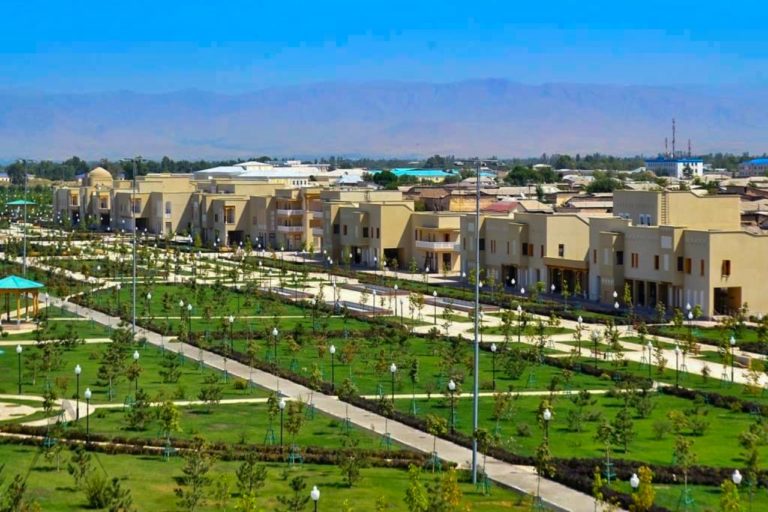
Ak Saray palace ruins in Shahrisabz
Ak Saray palace in Shahrisabz deserves its own page as the main sight of Shahrisabz. See more information on the palace through the link below.
Dorus Saodat Complex
A short walk East from the Kok-Gumbaz, sits the Dorus Saodat or Dor as-Siadat complex. It is a 3500-square meter mausoleum complex that Timur completed in 1392. The original complex, expanding 50 by 70 meters, was on a par with Tamerlane’s greatest plans. It arose on the death of his eldest and favorite son Jehangir, killed in 1375 at the age of only 22, falling from his horse.
As a favorite of his father, he was to become the heir to the throne. Jehangir was distinguished by a sharp mind, which allowed him to successfully study but he was also fearless in battle. Experiencing an irretrievable loss, Temur decided that a most beautiful mausoleum should be built in memory of his boundless love for his son. He called out for the best architects who lived in different parts of the Khorezm empire. A grandiose structure in memory of the heir was supposed to grow in the hometown of Temur – Shakhrisabz.
This structure was called Dorus-Saodat, or Dorusiadat. In Russian translated as “repository of power.” The building was not only the burial place of Tsarevich Jehangir but also other representatives of the Timurid clan.In 1404 in the records of the Spanish ambassador Clavijo observed: “By the special order of Timur the meat of twenty sheep is cooked and distributed in alms and this is being done in memory of his father and his son here daily.” Jehangir’s mausoleum, crumbling yet still impressive, is all that remains above ground.
A tiled corner tower reveals the mausoleum as the left column of a grand entrance facing the street, while the unusual conical dome, 27 meters high on a 16-sided drum, shows the handicraft of captured Khorezmian craftsmen. Photo by shagayu_po_tashkentu.

Khazreti Imam Mosque
Next to the memorial, in the Dorus-Saodat complex remained one more monumental construction of Temuridsky till today is the Mosque Hazrat-Imama. It is a 19th-century building with a charming wooden avian in the veranda (entry hall). It was signed by a wide silver-colored dome.
Even though it is not explicitly named in honor of one particular man, the inscription across the doors possibly related it to Abu Abdulla Muhammad ibn Nasr al Keshi, a local holy man in the 9th century, whose corpse legend says Tamerlane brought back from Baghdad. This significant sanctity provided local mullahs importance to prevent Abdullah Khan and other purgers of the Timurid legacy from destroying the whole complex.
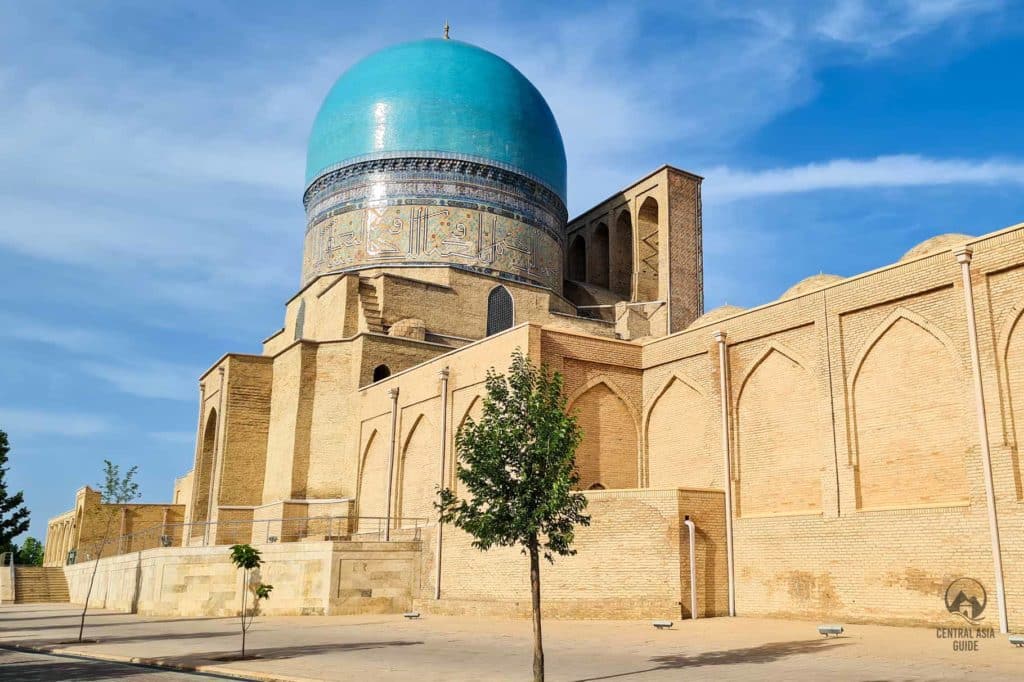
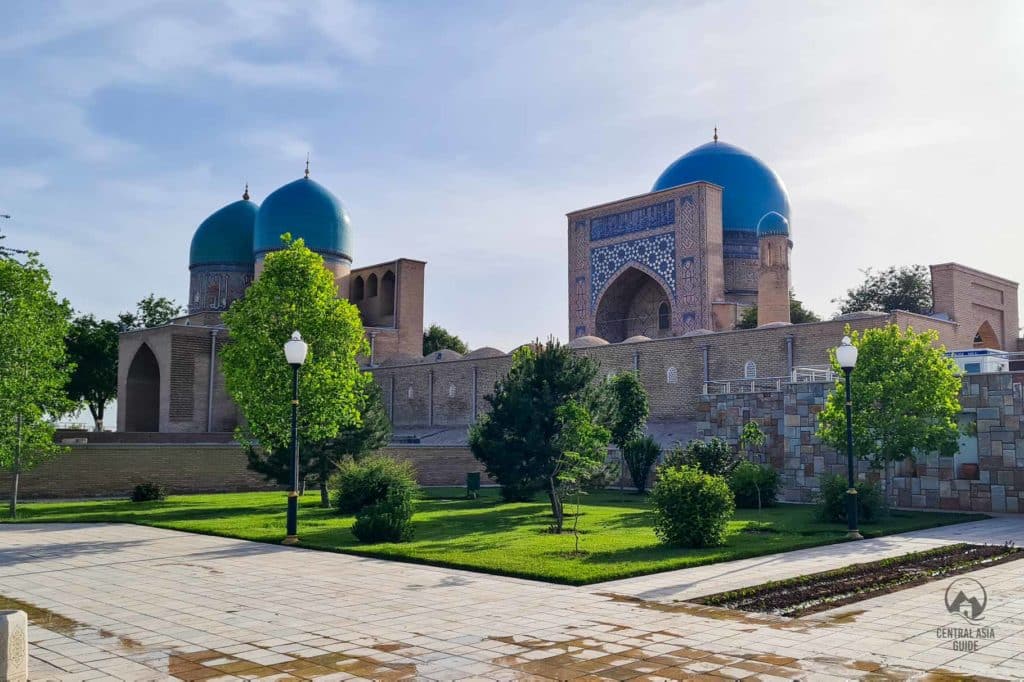
Dorut Tilavat Complex
Dorut Tilavat memorial complex is located in the southeastern part of Shahrisabz and at the southern end of the central park area. The buildings of the complex date back to the late 14-15th centuries. In 1360 or 1361, the remains of Emir Taragay (Timur’s father) ware placed to rest here. The appearance of the burial complex is connected with the name of the famous and respected religious minister – Sufi Shamseddin Kulyal. He was the spiritual teacher of both Taragai and Temur.
Shamseddin Kulyal was one of the authors of Sufism and Sheikh Bahauddin Nakshbandi’s mentor. He gained enormous respect even from his contemporaries, who rushed to him for help not only in religious but also in secular matters. Shamseddin Kulyal was from the potter’s family and became an associate of Temur’s father Taragay and was his mentor. His mausoleum was the earliest one built here. The Sheikh died in 1370 and his grave was surrounded by great veneration and worship.
Some parts of the Dorut Tilavat Complex have been set aside for a madrasah. It was the building where Tamerlane moved the remains of his father Taragay, so the madrasah became a mausoleum as well. In total the Dorut Tilavat ensemble includes tombs, a mosque, and a madrasah, and was completed during the reign of Temur’s grandson, the famous astronomer Ulugbek but there have also been later additions. The entrace was built in 1904 and in 1917 the yard was equipped with hujras.
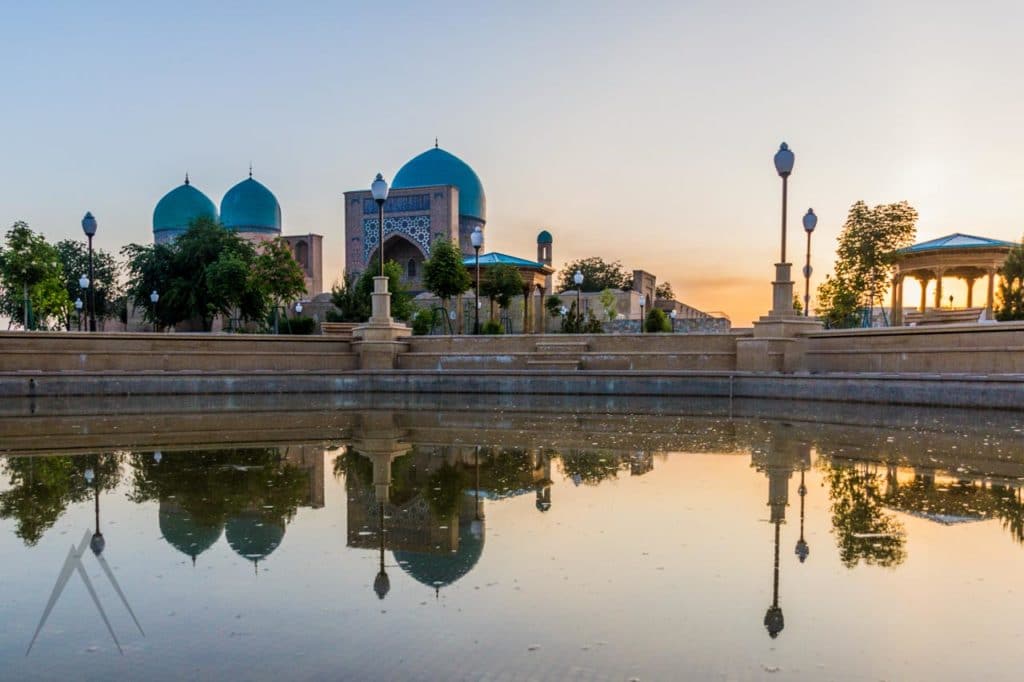
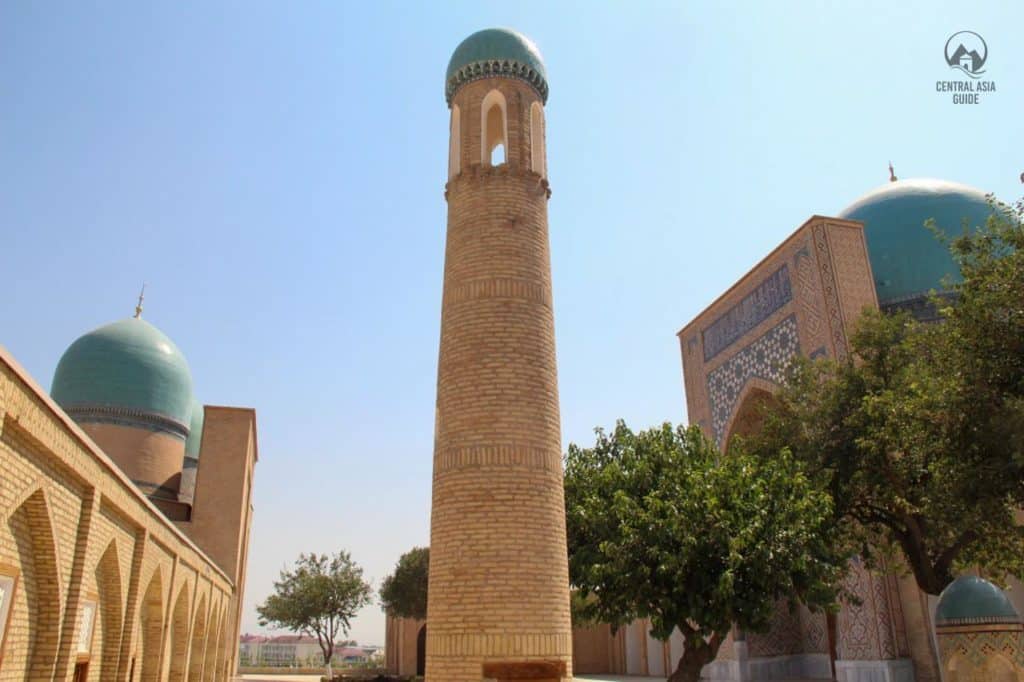
Kok Gumbaz Mosque
Kok Gumbaz Mosque is the largest mosque in the entire territory of Shakhrisabz and it is clearly recognized from its blue dome after which it is named. The structure was built by Tamerlane’s grandson Ulug Beg as Shakhrisabz’s Jumma (Friday) Mosque and the centerpiece of the Dorut Tilovat Complex and is attached to the tomb of Shamseddin Kulyal.
Kok-Gumbaz used to be the venue for the most important religious services. The building of the mosque is crowned by a huge dome covered with blue ceramic tiles. The internal space of Kok-Gumbaz mosque is almost square in its layout and has four deep niches carefully adapted to each corner of the earth. The entire wall surface was covered with ganch stucco and painted with intricate dark and light blue ornaments.
Shahrisabz Amir Timur Museum
Amir Timur Museum shows the local archaeological findings including for example clay works from the Ak Serai, an 18 kg set of chain mail and cannonballs used by Bukharan Emir Abdullah during an attack on the city. The highlight of Amir Timur museum in Shahrisabz is a model describing Timur’s entire kingdom, from Egypt to Kashgar.
Shahrisabz Chorsu Bazaar
Сhorsu domed bazaar is a typical Silk Road building built on the trade crossroads during the 15th century. Today the Shahrisabz Chorsu still serves its primary purpose. The outer dome covers an octagonal hall, which is surrounded by four smaller domes, each with its own portal.
The bustling stalls inside also spill out to the square outside. Among other things, one can find there nicely handmade Central Asian style wooden cribs, that are constructed with a hole in the base to facilitate the easy cleaning of the baby in the absence of a nappy. The bazar is located just next to the newly built park areas South from Ak Saray.

Travel to Shahrisabz
Bus / Taxi
There are regularly operated minibusses from Tashkent to Shahrisabz taking about 8 hrs. Shared taxis also run the same road and are faster but about twice the price. Shakhrisabz sits just in 90 km South of Samarkand, but the drive across the mountains still takes around two hours and in the winter even more if there is snow on the pass. Minibuses between Samarkand and Shakhrisabz take two hours and sometimes force you to change at Kitab. New bus station is located at the south part of town about 3,5 km from the city center.
Around Shahrisabz
If you are looking for a day trip from Shahrisabz, Katta Langar is a great choice. It is easily accessible with taxi and offers views to the country side on the way. Katta Langar’s main sights are a shrine and the overall natural beauty and village life of the area.
Destinations and sights near Shahrisabz
Page updated 1.6.2023